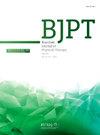The prevalence of sarcopenia and its associations with weekly energy expenditure and physical activity levels in female patients with breast cancer at the time of diagnosis
IF 3.2
3区 医学
Q1 ORTHOPEDICS
引用次数: 0
Abstract
Background
Early breast cancer diagnoses have enabled better therapeutic responses and better patient prognoses. However, sarcopenia, may develop as a result of this oncological disease, through the release of inflammatory cytokines.
Objectives
Determine the prevalence of sarcopenia and associations with weekly energy expenditure and physical activity (PA) levels in female patients with breast cancer at the time of diagnosis in a reference oncology hospital.
Methods
Cross-sectional study of patients with breast cancer stages IA to IIIC between June 2021 and June 2022. Sarcopenia was classified as “probable” when patients had low muscle strength, “confirmed” when both low strength and low muscle mass were detected, and “severe” when these two factors were associated with low physical performance. Muscle strength was assessed using dynamometry, muscle mass through calf circumference and physical performance using the Timed Up and Go test. PA level was determined by the International Physical Activity Questionnaire. Binary logistic regressions were performed between sarcopenia and PA levels, while linear regressions were performed for weekly energy expenditure.
Results
Ninety-two women were evaluated. Sarcopenia prevalence was determined as probable in 5.4 % and confirmed in 14.1 % of participants. It was observed that women classified as having probable or confirmed sarcopenia were older than those who were not sarcopenic. No significant differences concerning weekly energy expenditure and PA levels between groups were observed.
Conclusion
Less than a quarter of the assessed patients were diagnosed with probable or confirmed sarcopenia, and none were diagnosed with severe sarcopenia. No associations were observed between sarcopenia, weekly energy expenditure or PA levels.
女性乳腺癌患者在诊断时肌肉减少症的患病率及其与每周能量消耗和身体活动水平的关系
背景:乳腺癌的诊断使得更好的治疗反应和更好的患者预后。然而,这种肿瘤疾病可能通过炎症细胞因子的释放而导致肌肉减少症。目的了解某肿瘤医院女性乳腺癌患者肌少症的患病率及其与周能量消耗和体力活动(PA)水平的关系。方法对2021年6月至2022年6月期间乳腺癌IA至IIIC期患者进行横断面研究。当患者肌肉强度低时,肌肉减少症被分类为“可能的”,当检测到低强度和低肌肉质量时,肌肉减少症被分类为“确诊的”,当这两个因素与低体力表现相关时,肌肉减少症被分类为“严重的”。肌肉力量通过测力法进行评估,肌肉质量通过小腿围进行评估,体能表现通过Timed Up and Go测试进行评估。PA水平由国际体育活动问卷确定。在肌肉减少症和PA水平之间进行二元logistic回归,而对每周能量消耗进行线性回归。结果共对92名妇女进行了评估。骨骼肌减少症的患病率被确定为可能患病率为5.4%,确诊患病率为14.1%。据观察,被归类为可能或确诊的肌肉减少症的妇女比那些没有肌肉减少症的妇女年龄大。各组之间的周能量消耗和PA水平无显著差异。结论不到四分之一的患者被诊断为可能或确诊的肌肉减少症,没有人被诊断为严重的肌肉减少症。肌肉减少症、每周能量消耗或PA水平之间没有关联。
本文章由计算机程序翻译,如有差异,请以英文原文为准。
求助全文
约1分钟内获得全文
求助全文
来源期刊
CiteScore
6.10
自引率
8.80%
发文量
53
审稿时长
74 days
期刊介绍:
The Brazilian Journal of Physical Therapy (BJPT) is the official publication of the Brazilian Society of Physical Therapy Research and Graduate Studies (ABRAPG-Ft). It publishes original research articles on topics related to the areas of physical therapy and rehabilitation sciences, including clinical, basic or applied studies on the assessment, prevention, and treatment of movement disorders.

 求助内容:
求助内容: 应助结果提醒方式:
应助结果提醒方式:


